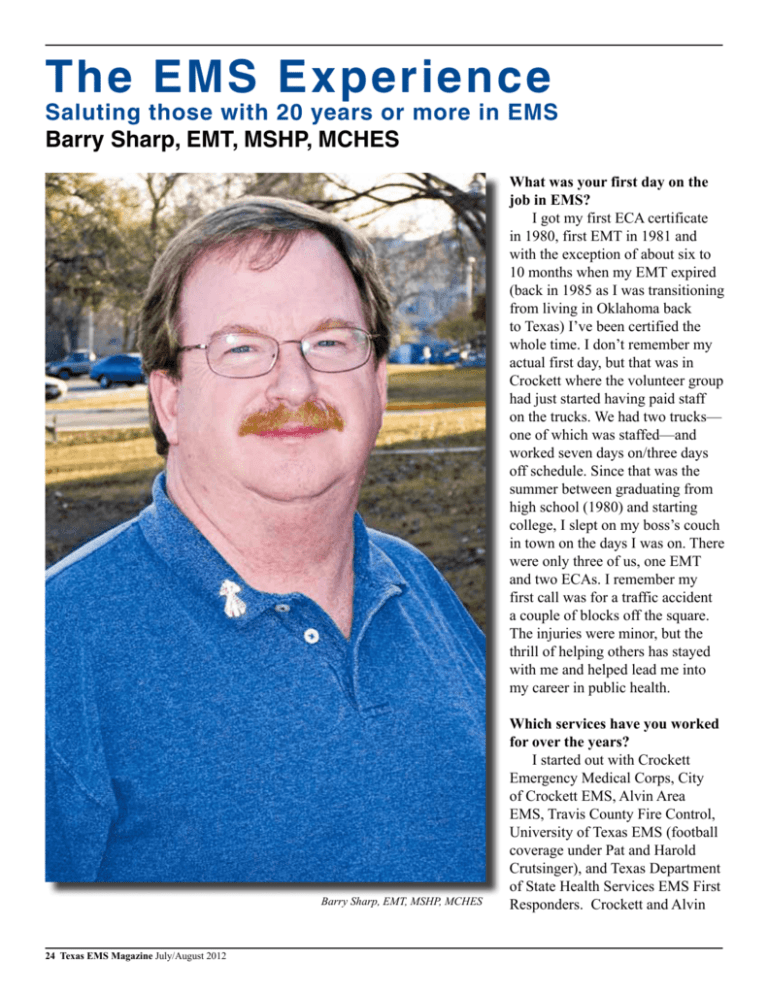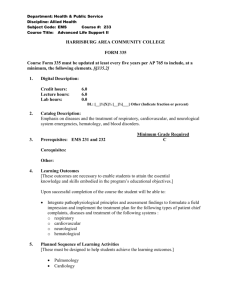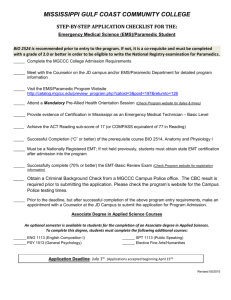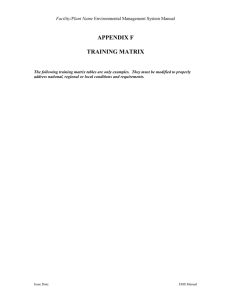The EMS Experience - Texas Department of State Health Services
advertisement

The EMS Experience Saluting those with 20 years or more in EMS Barry Sharp, EMT, MSHP, MCHES What was your first day on the job in EMS? I got my first ECA certificate in 1980, first EMT in 1981 and with the exception of about six to 10 months when my EMT expired (back in 1985 as I was transitioning from living in Oklahoma back to Texas) I’ve been certified the whole time. I don’t remember my actual first day, but that was in Crockett where the volunteer group had just started having paid staff on the trucks. We had two trucks— one of which was staffed—and worked seven days on/three days off schedule. Since that was the summer between graduating from high school (1980) and starting college, I slept on my boss’s couch in town on the days I was on. There were only three of us, one EMT and two ECAs. I remember my first call was for a traffic accident a couple of blocks off the square. The injuries were minor, but the thrill of helping others has stayed with me and helped lead me into my career in public health. Barry Sharp, EMT, MSHP, MCHES 24 Texas EMS Magazine July/August 2012 Which services have you worked for over the years? I started out with Crockett Emergency Medical Corps, City of Crockett EMS, Alvin Area EMS, Travis County Fire Control, University of Texas EMS (football coverage under Pat and Harold Crutsinger), and Texas Department of State Health Services EMS First Responders. Crockett and Alvin were full transport EMS systems; Travis County, UT and DSHS are first responders with Travis County and DSHS under the Austin/Travis County EMS system. So over the years I’ve done 9-1-1 transport, 9-1-1 first response, special events and corporate EMS. Lots of variety. Why did you get into EMS? It sounds hokey, but I grew up watching “Emergency!” and something clicked with me. Also, it was something I could do despite being deaf in one ear (which knocked out law enforcement). I have always been drawn toward the health and healing fields, and this was a way to put that into action. How has the field changed since you’ve been in it? The easier question might be what hasn’t changed since I started back in 1980. The equipment, from traction splints to the delivery of oxygen (remember demand valves?), has improved dramatically. The protocols and standards of care have risen to the point where basic EMTs are now doing things that were reserved for EMT-Paramedics or the ER when I first started. Today’s medics are much better trained in a higher level of skills and are working on trucks that are both better equipped and better designed for EMS work than what we used back then. Also, the typical emergency rooms where patients are being delivered to have improved as well, being able to handle things that back in that time would have been an automatic transfer to another facility. You haven’t lived until you have transported a patient in a low-top Suburban from your ER to a hospital a hundred miles away… only to have your siren speaker die six miles into the trip. Today, that wouldn’t happen. (Thanks goodness for Q2 sirens; when we fired that up in Tyler it looked like Moses parting the Red Sea.) Is there a particular moment or call that stands out? While I think I’ve had my fair share of trauma and cardiac that didn’t turn out well for the patient—and the minor calls that had a happy ending—there was one call on Christmas Day when I was with Travis County Fire Control. It was one where everything went like it does in the textbooks. We had a bicycle versus pickup accident in a residential area where two of us in Fire Control lived. I responded in my personal vehicle and the other guy brought the fire truck. The little girl was on her new bike and was struck and thrown. We get there, she’s lying on the curb and we can see blood underneath her bike helmet. Austin EMS arrived, Star Flight landed and the girl was treated, packaged and flown off in record time. I think we actually cleared the call about 30 minutes after the first tone dropped. She ended up with a broken leg and removed spleen. The blood was from where the helmet hit her when she landed on the curb, but she had no head injuries. She fully recovered and was doing fine the last I heard (this was 1988 or 1987). The driver of the truck was intoxicated and the investigating officer—a grandfatherly gent with a granddaughter about the same age as the patient—had him in the back of his patrol car when we all left the scene. This was one of those calls where everything clicked and worked just like it was supposed to do. It doesn’t always happen, but it is cool when it does. What has been your favorite part of your career in EMS? Though my time in EMS has been nearly all as a volunteer, my favorite part is that I have a chance to help people when they are at their worst and to try and make their world a little better even if it’s just for a brief moment—to let folks know that someone cares and is trying to help them or their loved one. We’re put on the earth to serve the needs of others and this is one way I try to do that. It was my EMS activities that led my wife to become an EMT when we were in Alvin (and still young married folks) which led her to a career in nursing. And there was a young man who worked for me in Alvin that got involved in EMS and promptly left me in his dust as he made EMS his profession, becoming an EMS commander in Beaumont. Being able to help others grow is a great part of the job. July/August 2012 Texas EMS Magazine 25







